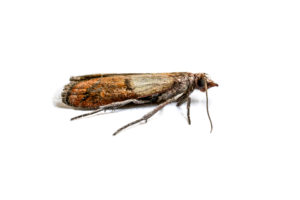Indianmeal moths

Seeing small moths around your home? Your pantry may be at risk.
The occasional moth in your home most likely came from outside and isn’t anything to be concerned about. However, if you are seeing a large population of moths inside your home, particularly close to your kitchen, you may be dealing with something more concerning: Indianmeal moths.
What are Indianmeal moths?
Indianmeal moths are small, with a wingspan of just 16mm. They can best be recognized by the distinctive brownish-orange pattern on the back of their wings.
Why are they a threat to my home?
Adult Indianmeal moths, while a bit of a nuisance, don’t cause any real harm to your home. Though the adults are the most obvious sign of an infestation, the real problem comes from their larvae.
The adult moths lay eggs in close proximity to dry food sources such as rice, cornmeal, flour, and even pet food. As they grow, the larvae will feed on all surrounding food sources, contaminating anything they don’t consume in the process.
If left unchecked, your pantry can become a breeding ground for a new generation of Indianmeal moths!
Beyond the gross factor, the contamination and spoilage caused by these infestations cause can be a health risk. If the infestation is allowed to grow, the exponential increase in the population can make it challenging to completely eradicate the Indianmeal moths from your home.
Why are they so difficult to detect?
While the adult moths are a sure sign of infestation, it often isn’t obvious that your home is infested until things really get out of hand.
Indianmeal moths are attracted to light sources, and this may cause them to wander far from the heart of the infestation. For this reason, tracing the adult moths back to the site of an infestation isn’t always straightforward.
It may require a professional inspection to track down the heart of the infestation.
How do I get rid of them?
Dealing with an active infestation starts with removing the food source. Oftentimes Indianmeal moth larvae will infest old or neglected stored food, so it’s time to clean out the back of your cabinets.
Give your pantry and kitchen a thorough cleaning. Throw out anything old or anything that looks potentially contaminated. The larvae leave behind a silk webbing when they feed, so throw out anything that appears to be infested.
Be very thorough in your investigation. If even a single infested food source is left, the Indianmeal moth population will continue to grow.
If you’re still having problems after getting rid of infested food, the next step is to call in a pest control professional.
Oftentimes continued problems are the result of an undiscovered hotspot of pest activity. A comprehensive inspection from a pest expert uncovers any evidence of pest activity as well as any conducive conditions which encourage infestations.
If you are dealing with Indianmeal moths or any other pest, Canton Termite and Pest Control is your one-call solution! Give us a call TODAY at 770-479-1598 and start living PEST FREE!
By: Tim
